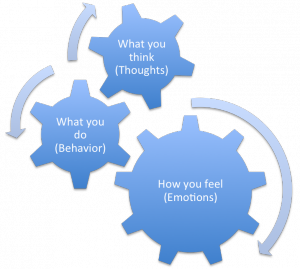Cognitive-behavioral Strategies in the Classroom
 For many years, our research team has worked with a variety of teachers and students with a wide range of behavioral needs and what we have seen over and over again is that when teachers use cognitive-behavioral strategies in their classroom, the effects on student behavior have been positive. Cognitive-behavioral interventions (CBIs) are becoming recognized as a viable, research-based approach appropriate for use in school settings.
For many years, our research team has worked with a variety of teachers and students with a wide range of behavioral needs and what we have seen over and over again is that when teachers use cognitive-behavioral strategies in their classroom, the effects on student behavior have been positive. Cognitive-behavioral interventions (CBIs) are becoming recognized as a viable, research-based approach appropriate for use in school settings.
In the clinical fields of psychiatry and mental health the appraoch is called cognitive-behavioral therapy and it has been successfully used in hospitals, residential treatment facilities, and outpatient clinics to treat conditions such as obsessive-compulsive disorder, obesity, anxiety and panic disorder, social phobia, eating disorders, alcohol and drug dependency, attention deficit hyperactivity disorder (ADHD), and problems with anger and aggression. Due to positive results in clinical settings, CBIs have gained favor in school settings.
So, what exactly is a CBI? When teachers use a CBI, they can help their students control their own behavior, rather than attempting to control student behavior with external reinforcement alone (e.g., tokens for staying on task, praise for raising hand). CBIs teach students to use their inner speech to affect or to modify their underlying thinking, which in turn affects the way they behave. Simply put, inner speech (also known as covert self-instruction) consists of talking to oneself to solve a problem or guide behavior. Cognitive strategies can help students learn “how-to-think”, instead of “what-to-think.” CBIs are student operated, as opposed to more traditional teacher operated systems, meaning that they are based on students’ self-control rather than external rewards and punishments. While we all know the benefits of using rewards (good) and punishments (use with caution!) in the classroom, we argue that it is even more important to teach students how to use their thinking to improve their own behavior.
So how are CBIs taught, and what are the benefits? CBI curricula, such as our Tools for Getting Along: Teaching Students to Problem Solve for upper elementary students (and Take CHARGE! for junior high/middle school), provide instructional techniques such as explicit teaching and use of modeling, role-playing, feedback, reinforcement, and cognitive components that include cognitive modeling through teacher think-alouds. Changing students’ inner speech and teaching them how to think can influence their behaviors such as hitting, pushing, or teasing. Individuals can learn to develop and use self-instruction to inform more positive behavioral choices. Numerous studies demonstrate that teaching children cognitive strategies can strengthen pro-social behavior and decrease maladaptive behaviors like hyperactivity/impulsivity, disruption, and aggression. In a nutshell, by using CBIs within the classroom, you can equip your students with the skills to remain in control of their behavioral choices in a variety of settings, even when teachers are not around.
Here are some resources you may find helpful that include cogntive-behavioral strategies:
Curricula
1. Tools for Getting Along which has been reviewed by National Registry of Evidence-based Programs and Practices and by the U.S. Department of Education’s What Works Clearinghouse.
2. Take CHARGE! (same as Tools for Getting Along except for junior high/middle school)
Books
1. A Teacher’s Guide to Preventing Behavior Problems in the Elementary Classroom
(Stephen W. Smith, Ph.D. & Mitchell Yell, Ph.D.)
(Stephen W. Smith, Ph.D. & Ann P. Daunic, Ph.D)
3. Preventing Problem Behaviors: Schoolwide Programs and Classroom Practices
(Robert F. Algozzine, Ph.D., Ann P. Daunic, Ph.D., Stephen W. Smith, Ph.D.)





